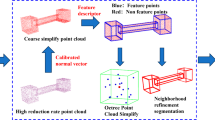Reverse engineering refers to the process of obtaining a CAD model from an existing physical part. Advances in laser scanning technologies have facilitated this process by sampling part surface data with speed and accuracy. With the help of this technology, it is now possible to acquire the geometry of a part having complex and freeform surfaces. However, it creates the burden of large amounts of point data which must be manipulated, therefore, data from a laser scan must be significantly reduced to proceed with the computations and to lower the storage requirement. Many point data reduction methods for image processing have been developed in the past. However, there is little published work on laser-scanned data, and what exists focuses only on 2D point data. This paper presents a data reduction method that reduces the amount of 3D point data using part geometry information. The method reduces the point data, based on normal values of points using 3D grids. The method is applied to two sample models and the results are discussed.
Similar content being viewed by others
Author information
Authors and Affiliations
Rights and permissions
About this article
Cite this article
Lee, K., Woo, H. & Suk, T. Point Data Reduction Using 3D Grids. Int J Adv Manuf Technol 18, 201–210 (2001). https://doi.org/10.1007/s001700170075
Issue Date:
DOI: https://doi.org/10.1007/s001700170075




